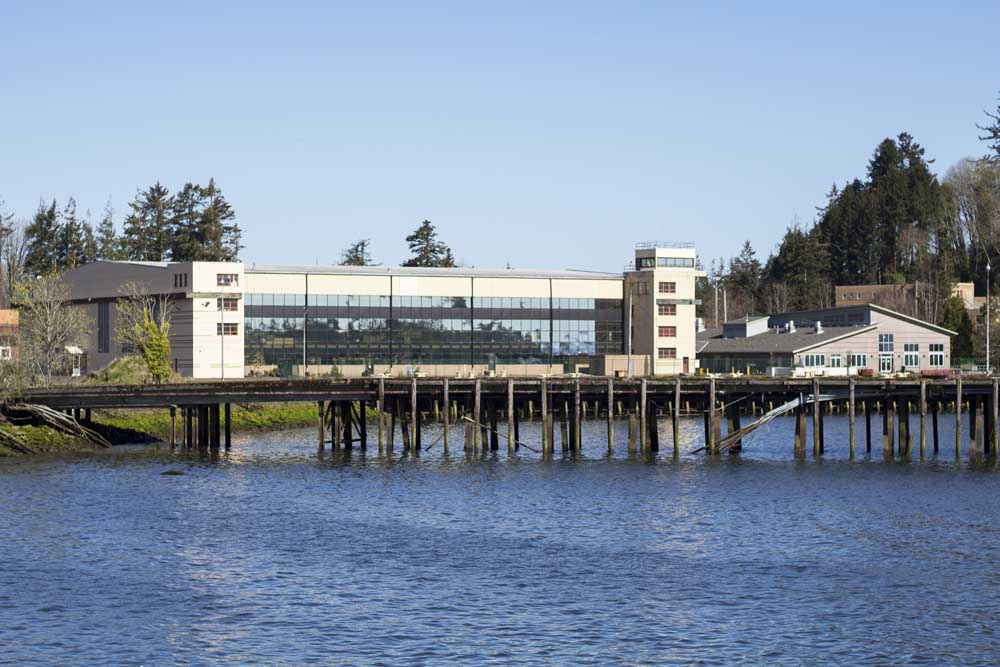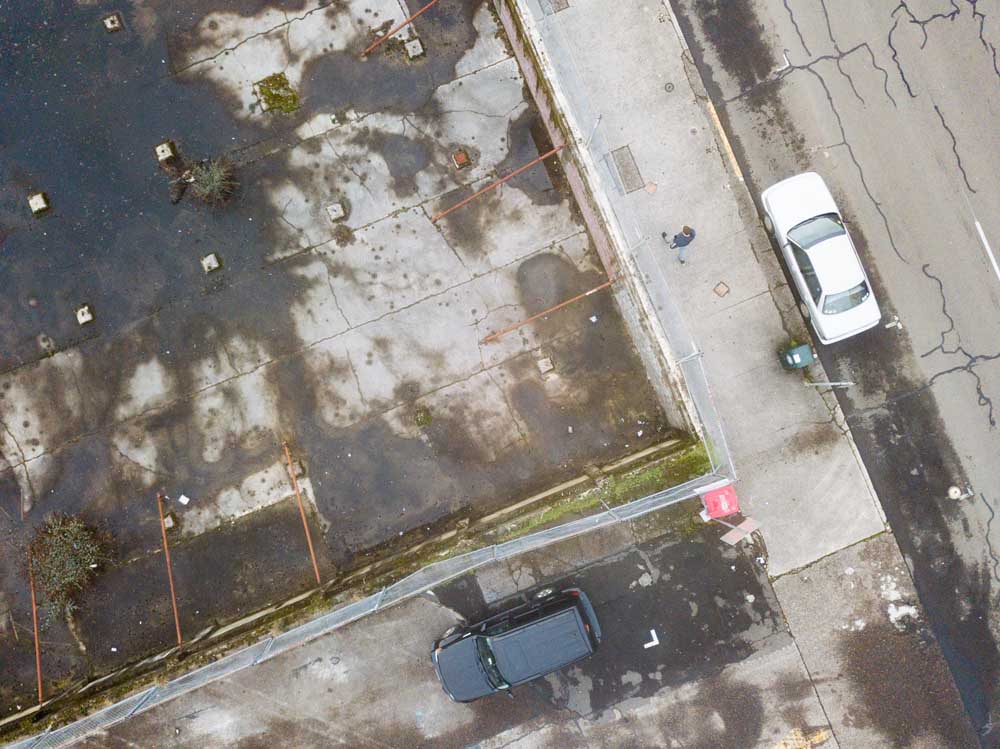Inedible shrimp take over key oyster bed
Published 5:55 am Friday, August 5, 2016

- The shrimp burrow up from below when coming to the surface, their tunnels displacing much of the native eel grass that holds the mud of Willapa Bay together.
WILLAPA BAY, Wash. — Imagine your once-profitable farm is now covered with tens of thousands of mole burrows, a desert of holes and naked dirt. Now imagine needing a government permit to control this population explosion — a permit issued and then withdrawn last year, and now once again creeping through the bureaucracy.
Transfer this scenario to Willapa Bay and substitute burrowing shrimp for moles, and you have some idea of the anxiety gripping local oyster growers.
Last week, prominent Willapa oysterman Dave Nisbet’s crew hurried to evacuate oysters from a vital bed near the mouth of Cedar River, racing to move them before they smother and die in loose muck churned up by the prolific shrimp.
“We’ve got a bed up there at Cedar River, actually at this time it’s our best fattening bed,” said Nisbet, 65. “There’s a lot of infestation all around that bed in the Tokeland area … So we’re abandoning. We’re in the process of moving all the oysters off the bed. It’s 80 acres, so it’s a big bed and it’s going to be a big hit.”
Collectively known as burrowing shrimp, the bay harbors two native species — ghost shrimp and blue mud shrimp. Although they’ve been trying to expand their range for decades, they are especially prolific this year, thriving in unusually warm 70-degree bay water. The shrimp aren’t edible by humans. In contrast, oysters generate an annual total of about $35 million for the Pacific County economy.
Nisbet employs 95 Pacific County workers, who are paid $2.7 million a year. These workers put 100 kids in schools in the South Bend, Naselle and Raymond districts. Loss of the Cedar River bed will cost his farm hundreds of thousands of dollars this year alone, resulting in Nisbet’s business shrinking.
Traveling by boat across the Bay Center Channel of Willapa Bay, headed north from Nisbet’s Goose Point Oysters, farm manager Francisco Meliton pilots his skiff slowly. The way can be tricky, especially when the tide is out. The route is shallow in parts and he lets off the throttle. After a few minutes the boat speeds up again and the houses that line the sea wall in Tokeland come into view as the boat approaches the port. At its entry, located on top of a navigational beacon, a pair of gulls have made a nest with babies inside. Meliton makes bird calls as he approaches, the adult birds chirping back at him.
As the boat pulls up to the shore of an expansive oyster bed, Goose Point biologist Brian Kingzett warns that when walking on the tidal flats it’s best not to plant your heels when you walk, in order to avoid having your leg swallowed by the mud in the areas infested by burrowing shrimp.
The mud on the eastern side of the location still has a fair amount of eelgrass, which creates a support system of roots under the surface that allows oysters to sit above the mud during high tide. However, the western portion of this particular plot looks more like the surface of the moon, porous and devoid of eelgrass, leaving oysters to sink in to the mud and die.
Meliton has to make his rounds, inspecting the stock throughout this bed. As he ventures into the shrimp-infested area he goes from sliding his feet along the surface to sinking up to his knees, as if he were caught in quick sand. Meliton comes back with a handful of seven or eight shrimp, with their oversized, mutant-looking claws sticking out in front of their tiny bodies.
You wouldn’t think that something so small could do so much damage. But looking at the land where he found them — riddled with thousands of holes, no eelgrass or living oysters to be seen — it is very obvious that these tiny menaces are continuing to gain a claw-hold on the oyster mecca that is Willapa Bay.
Last year, oyster and clam growers in Willapa Bay and Grays Harbor planned to spray up to 2,000 acres of tidelands with imidacloprid, a neonicotinoid pesticide, to control the shrimp. The Washington Department of Ecology issued a permit April 16, 2015, but Puget Sound-based Taylor Shellfish Farms said May 1 it would not spray its Willapa Bay beds following a negative reaction to spraying, largely generated by Seattle Times columnist Danny Westneat.
Two days later, the Willapa-Grays Harbor Oyster Growers Association told DOE it was suspending the permit. Later, growers learned DOE considered the action to be an outright surrender and cancellation of the permit, meaning the process had to start from scratch this year, with a goal of obtaining a new permit for shrimp control in 2017.
Imidacloprid was set to replace carbaryl, an older insecticide commonly used in flea collars for pets. Carbaryl’s use in the bay resulted in lawsuits and increasing regulations, and Willapa Bay and Grays Harbor shellfish industry agreed more than a decade ago to phase it out.
The alternative oyster growers eventually proposed is Imidacloprid. It is widely used on land crops, including Washington hops. The U.S. Environmental Protection Agency and Washington State Department of Agriculture approved using it specifically in the bay and harbor, even though it is controversial in other settings, being sometimes blamed for honeybee die-offs.
Shellfish growers were to apply 1/16th as much Imidacloprid per acre as they did carbaryl, which was used between 1963 and 2013. Imidacloprid was to be applied at a low level — one 8-ounce cup per acre — on tidal flats where Nisbet hasn’t seen a bee in a 35-year career.
“The sad thing about this is that I don’t think the public really understands that it was designed for aquatic use and is so benign that a good application doesn’t even kill them, it just puts them to sleep,” Nisbet said regarding Imidacloprid. After the shrimp are anesthetized, they stop filtering the surrounding sediment. Tidal action collapses their burrows on them and the chemical disappears.
“It just breaks down, it’s harmless, it’s a good fit. It’s a very, very light touch,” Nisbet said.
Going back to carbaryl isn’t an option. The EPA no longer registers it as an aquatic pesticide, and DOE has closed off any chance growers could revive their old permit to use it, DOE spokesman Chase Gallagher said.
Fattening beds like those off Cedar River are in short supply around Willapa Bay. Usually in places with lots of ocean tidal influence and other special characteristics, they bathe oysters in nutrients, allowing them to plump up and become delicious.
It has now been at least three years since there was any type of shrimp control on Nisbet’s Cedar River fattening bed, and shrimp are popping up everywhere like dandelions in a neglected yard.
“There’s a lot of infestation all around that bed in the Tokeland area and it doesn’t take much for that infestation to come in and just take it out. We’re abandoning. We’re in the process of moving all the oysters off the bed. It’s 80 acres, so it’s a big bed and it’s going to be a big hit,” Nisbet said.
The oysters are being moved to less nutritious beds Nisbet owns elsewhere in the bay. (Washington is somewhat unique in conferring private ownership rights on tidelands that are periodically underwater.)
“You have to use some other beds that don’t fatten as quick. It’ll slow down our process and so we’re probably not going to be able rotate the volume off that we’re used to taking off, so quick frankly we’re going to have slow down a little bit. I’m not sure how it’s going to go,” he said.
Unless DOE re-grants the permit for Imidacloprid so it can be applied with hand-held spray wands in time for next year, “Those 80 acres will be a dead loss, there’s nothing we can do with it,” Nisbet said.
Kathleen Nisbet Moncy, Dave’s daughter, said “We’re losing our key fattening bed, which will change our whole farming plan.” Economic impacts from this will ripple through local communities, she noted. Without the money oystering brings it, working docks become little more than picturesque backdrops for tourists and condos, she said.
Beyond damage to their own business, Nisbet and Moncy said they fear consequences of out-of-control shrimp populations on the ecology of the bay.
Most Willapa oystermen raise oysters in a way that somewhat mimics the natural oyster beds that were found here when people first arrived.
“Oysters on a bed provide kind of a 3-D matrix. That dimensional matrix means you’ve got eelgrass, you’ve got crab habitat. Dungeness juvenile crab like to hide underneath the oysters. Then you’ve got your sticklebacks, you’ve got fish and other sorts of things that swim around,” Nisbet said. “So you’ve got this big bio-diverse habitat that having oysters on a bed provide. When you lose that 3-D — when the oysters go off the beds — you lose that habitat for crabs and fish and birds. When the shrimp come up, you lose everything. You lose the eelgrass. It’s all gone. So the productivity leaves. … I know on the oyster beds, it’s really rich; and I know on the shrimp beds, it’s a desert.”
Moncy said the explosion in shrimp numbers resembles the former takeover of the bay by invasive spartina grass, except that the shrimp are unnoticed from shore.
“What really saddens me,” she said, “is that [the shrimp] affect the estuary on so many levels, and our community on so many different levels. We’re the only ones that are bracing ourselves for it. I think it’s going to be trouble for all our little towns we have here that rely on fishing and crabbing and enjoying the estuary in general.”
The continuing loss of oyster lands will result in a biologically poorer place, Moncy said. Speaking of the public, “They don’t realize the devastation that’s happening out there on such a large scale,” she said.
Like spartina, which was eventually eliminated thanks to a concerted chemical control program, Moncy said the shrimp can be kept within reasonable bounds if farmers and agencies cooperate. There is no intention to try to eradicate the shrimp.
“This is a short-term issue that we actually have a solution for, and as oyster farmers we’re never going to stop looking for other alternatives and other solutions for this issue, because this is our home,” she said.
— Damian Mulinix and Don Jenkins contributed to this story.





